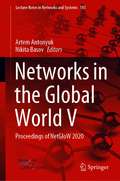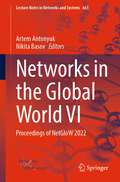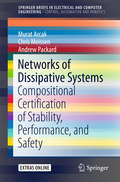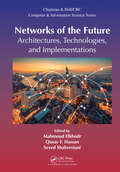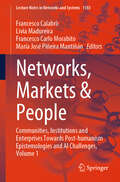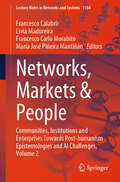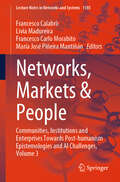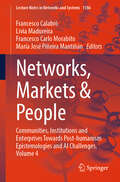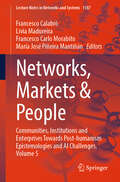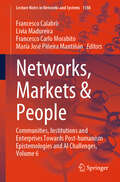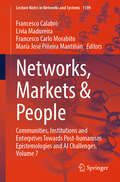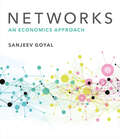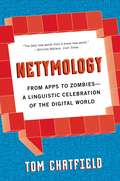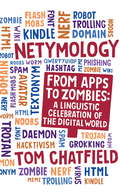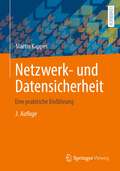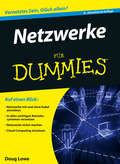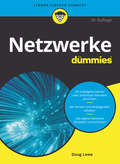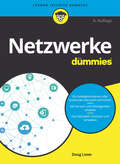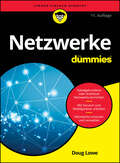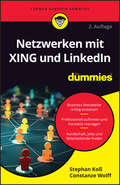- Table View
- List View
Networks in the Global World V: Proceedings of NetGloW 2020 (Lecture Notes in Networks and Systems #181)
by Artem Antonyuk Nikita BasovThis proceedings book presents state-of-the-art developments in theory, methodology, and applications of network analysis across sociology, computational science, education research, literature studies, political science, international relations, social media research, and urban studies. The papers comprising this collection were presented at the Fifth ‘Networks in the Global World’ conference organized by the Centre for German and European Studies of St. Petersburg University and Bielefeld University and held on July 7–9, 2020. This biannual conference series revolves around key interdisciplinary issues in the focus of network analysts, such as the multidimensional approach to social reality, translation of theories and methods across disciplines, and mixing of data and methods. The distinctive features of this book are the emphasis on in-depth linkages between theory, method, and applications, the blend of qualitative and quantitative methods, and the joint consideration of different network levels, types, and contexts. The topics covered by the papers include interrelation of social and cultural structures, constellations of power, and patterns of interaction in areas ranging from various types of communities (local, international, educational, political, and so on) to social media and literature. The book is useful for practicing researchers, graduate and postgraduate students, and educators interested in network analysis of social relations, politics, economy, and culture. Features that set the book apart from others in the field: · The book offers a unique cross-disciplinary blend of computational and ethnographic network analyses applied to a diverse spectrum of spheres, from literature and education to urban planning and policymaking. · Embracing conceptual, methodological, and empirical works, the book is among the few in network analysis to emphasize connections between theory, method, and applications. · The book brings together authors and empirical contexts from all over the globe, with a particular emphasis on European societies.
Networks in the Global World VI: Proceedings of NetGloW 2022 (Lecture Notes in Networks and Systems #663)
by Artem Antonyuk Nikita BasovThis book covers relations between social and cultural structures, power, and interaction in communities, social media, and literature. The areas range from politics and urban planning to literature and education. The collected chapters were presented at the Sixth ‘Networks in the Global World’ conference held on June 22–24, 2022. This biannual conference series revolves around key interdisciplinary issues in the focus of network analysts, such as the multidimensional approach to social reality, translation of theories and methods across disciplines, and mixing of data and methods. The topics covered by the chapters cover relations between social and cultural structures, power, and interaction in communities, social media, and literature. The book is useful for practicing researchers, graduate and post-graduate students, and educators interested in social relations, politics, economy, and culture.
Networks in the Russian Market Economy
by Markku LonkilaA PDF version of this book is available for free in open access via the OAPEN Library platform, www. oapen. org. This book examines the significance of networks among the firms operative in the contemporary Russian software industry in the St. Petersburg region.
Networks of Communication in South Africa: New Media, New Technologies
by R. SooryamoorthyWithin a short period of time, South Africa has made remarkable progress in the adoption of mobile and Internet technologies. In this landmark study, R. Sooryamoorthy examines the development of communication patterns, social contacts and networks in South Africa. Based on pioneering quantitative and qualitative data, he analyses trends in changing media use in Africa, showing the development of the use of new media for communication by South Africans of all ages, races and genders in relation to the development of media infrastructure, its cost and government policy. It shows how people use the media for communication purposes that affirm or break their social contacts and networks, and how they apply media to establish, re-establish or maintain social relationships. This book will be of interest to those researching the growth of communication technology in Africa, as well as those involved in the wider fields of development studies and economics.
Networks of Dissipative Systems
by Andrew Packard Murat Arcak Chris MeissenThis book addresses a major problem for today's large-scale networked systems: certification of the required stability and performance properties using analytical and computational models. On the basis of illustrative case studies, it demonstrates the applicability of theoretical methods to biological networks, vehicle fleets, and Internet congestion control. Rather than tackle the network as a whole --an approach that severely limits the ability of existing methods to cope with large numbers of physical components-- the book develops a compositional approach that derives network-level guarantees from key structural properties of the components and their interactions--the book addresses this problem by pursuing a compositional approach that derives network-level guarantees from key structural properties of the subsystems and their interactions. The foundational tool in this approach is the established dissipativity theory, which is reviewed in the first chapter and supplemented with modern computational techniques. The book blends this theory with the authors' recent research efforts at a level that is accessible to graduate students and practising engineers familiar with only the most basic nonlinear systems concepts. Code associated with the numerical examples can be downloaded at extras. springer. com, allowing readers to reproduce the examples and become acquainted with the relevant software.
Networks of the Future: Architectures, Technologies, and Implementations (Chapman & Hall/CRC Computer and Information Science Series)
by Seyed Shahrestani Qusay F. Hassan Mahmoud ElkhodrWith the ubiquitous diffusion of the IoT, Cloud Computing, 5G and other evolved wireless technologies into our daily lives, the world will see the Internet of the future expand ever more quickly. Driving the progress of communications and connectivity are mobile and wireless technologies, including traditional WLANs technologies and low, ultra-power, short and long-range technologies. These technologies facilitate the communication among the growing number of connected devices, leading to the generation of huge volumes of data. Processing and analysis of such "big data" brings about many opportunities, as well as many challenges, such as those relating to efficient power consumptions, security, privacy, management, and quality of service. This book is about the technologies, opportunities and challenges that can drive and shape the networks of the future. Written by established international researchers and experts, Networks of the Future answers fundamental and pressing research challenges in the field, including architectural shifts, concepts, mitigation solutions and techniques, and key technologies in the areas of networking. The book starts with a discussion on Cognitive Radio (CR) technologies as promising solutions for improving spectrum utilization, and also highlights the advances in CR spectrum sensing techniques and resource management methods. The second part of the book presents the latest developments and research in the areas of 5G technologies and Software Defined Networks (SDN). Solutions to the most pressing challenges facing the adoption of 5G technologies are also covered, and the new paradigm known as Fog Computing is examined in the context of 5G networks. The focus next shifts to efficient solutions for future heterogeneous networks. It consists of a collection of chapters that discuss self-healing solutions, dealing with Network Virtualization, QoS in heterogeneous networks, and energy efficient techniques for Passive Optical Networks and Wireless Sensor Networks. Finally, the areas of IoT and Big Data are discussed, including the latest developments and future perspectives of Big Data and the IoT paradigms.
Networks, Crowds, and Markets
by David Easley Jon KleinbergAre all film stars linked to Kevin Bacon? Why do the stock markets rise and fall sharply on the strength of a vague rumour? How does gossip spread so quickly? Are we all related through six degrees of separation? There is a growing awareness of the complex networks that pervade modern society. We see them in the rapid growth of the Internet, the ease of global communication, the swift spread of news and information, and in the way epidemics and financial crises develop with startling speed and intensity. This introductory book on the new science of networks takes an interdisciplinary approach, using economics, sociology, computing, information science and applied mathematics to address fundamental questions about the links that connect us, and the ways that our decisions can have consequences for others.
Networks, Markets & People: Communities, Institutions and Enterprises Towards Post-humanism Epistemologies and AI Challenges, Volume 1 (Lecture Notes in Networks and Systems #1183)
by Francesco Carlo Morabito Francesco Calabrò María José Piñeira Mantiñán Livia MadureiraThis book aims to address the issue of the effects that the contemporary environmental, technological, social and economic global challenges produce on settlement systems, communities, institutions and enterprises. It presents a multi-disciplinary scientific debate on the new frontiers of strategic and spatial planning, decision support tools and ecological design, within the urban-rural areas networks and the metropolitan cities of the Mediterranean basin. The book focuses on five topics: Cultural Heritage as driver of development for territories and tourism destinations; Ecosystems, people-nature cohesion and urban-rural relationships; Decision Support Systems for urban regeneration; Policies and practices of cohesion and social innovation for inclusive cities; Green buildings and sustainable solutions for ecological transition. In addition, the book hosts the papers of a special session intercluster promoted by Italian Society of Architectural Technology (SITdA). The book benefits all researchers, practitioners and policymakers interested in the issue applied to metropolitan cities and marginal areas.
Networks, Markets & People: Communities, Institutions and Enterprises Towards Post-humanism Epistemologies and AI Challenges, Volume 2 (Lecture Notes in Networks and Systems #1184)
by Francesco Carlo Morabito Francesco Calabrò María José Piñeira Mantiñán Livia MadureiraThis book aims to address the issue of the effects that the contemporary environmental, technological, social and economic global challenges produce on settlement systems, communities, institutions and enterprises. It presents a multi-disciplinary scientific debate on the new frontiers of strategic and spatial planning, decision support tools and ecological design, within the urban-rural areas networks and the metropolitan cities of the Mediterranean basin. The book focuses on five topics: Cultural Heritage as driver of development for territories and tourism destinations; Ecosystems, people-nature cohesion and urban-rural relationships; Decision Support Systems for urban regeneration; Policies and practices of cohesion and social innovation for inclusive cities; Green buildings and sustainable solutions for ecological transition. In addition, the book hosts the papers of a special session intercluster promoted by Italian Society of Architectural Technology (SITdA). The book benefits all researchers, practitioners and policymakers interested in the issue applied to metropolitan cities and marginal areas.
Networks, Markets & People: Communities, Institutions and Enterprises Towards Post-humanism Epistemologies and AI Challenges, Volume 3 (Lecture Notes in Networks and Systems #1185)
by Francesco Carlo Morabito Francesco Calabrò María José Piñeira Mantiñán Livia MadureiraThis book aims to address the issue of the effects that the contemporary environmental, technological, social and economic global challenges produce on settlement systems, communities, institutions and enterprises. It presents a multi-disciplinary scientific debate on the new frontiers of strategic and spatial planning, decision support tools and ecological design, within the urban-rural areas networks and the metropolitan cities of the Mediterranean basin. The book focuses on five topics: Cultural Heritage as driver of development for territories and tourism destinations; Ecosystems, people-nature cohesion and urban-rural relationships; Decision Support Systems for urban regeneration; Policies and practices of cohesion and social innovation for inclusive cities; Green buildings and sustainable solutions for ecological transition. In addition, the book hosts the papers of a special session intercluster promoted by Italian Society of Architectural Technology (SITdA). The book benefits all researchers, practitioners and policymakers interested in the issue applied to metropolitan cities and marginal areas.
Networks, Markets & People: Communities, Institutions and Enterprises Towards Post-humanism Epistemologies and AI Challenges, Volume 4 (Lecture Notes in Networks and Systems #1186)
by Francesco Carlo Morabito Francesco Calabrò María José Piñeira Mantiñán Livia MadureiraThis book aims to address the issue of the effects that the contemporary environmental, technological, social and economic global challenges produce on settlement systems, communities, institutions and enterprises. It presents a multi-disciplinary scientific debate on the new frontiers of strategic and spatial planning, decision support tools and ecological design, within the urban-rural areas networks and the metropolitan cities of the Mediterranean basin. The book focuses on five topics: Cultural Heritage as driver of development for territories and tourism destinations; Ecosystems, people-nature cohesion and urban-rural relationships; Decision Support Systems for urban regeneration; Policies and practices of cohesion and social innovation for inclusive cities; Green buildings and sustainable solutions for ecological transition. In addition, the book hosts the papers of a special session intercluster promoted by Italian Society of Architectural Technology (SITdA). The book benefits all researchers, practitioners and policymakers interested in the issue applied to metropolitan cities and marginal areas.
Networks, Markets & People: Communities, Institutions and Enterprises Towards Post-humanism Epistemologies and AI Challenges, Volume 5 (Lecture Notes in Networks and Systems #1187)
by Francesco Carlo Morabito Francesco Calabrò María José Piñeira Mantiñán Livia MadureiraThis book aims to address the issue of the effects that the contemporary environmental, technological, social and economic global challenges produce on settlement systems, communities, institutions and enterprises. It presents a multi-disciplinary scientific debate on the new frontiers of strategic and spatial planning, decision support tools and ecological design, within the urban-rural areas networks and the metropolitan cities of the Mediterranean basin. The book focuses on five topics: Cultural Heritage as driver of development for territories and tourism destinations; Ecosystems, people-nature cohesion and urban-rural relationships; Decision Support Systems for urban regeneration; Policies and practices of cohesion and social innovation for inclusive cities; Green buildings and sustainable solutions for ecological transition. In addition, the book hosts the papers of a special session intercluster promoted by Italian Society of Architectural Technology (SITdA). The book benefits all researchers, practitioners and policymakers interested in the issue applied to metropolitan cities and marginal areas.
Networks, Markets & People: Communities, Institutions and Enterprises Towards Post-humanism Epistemologies and AI Challenges, Volume 6 (Lecture Notes in Networks and Systems #1188)
by Francesco Carlo Morabito Francesco Calabrò María José Piñeira Mantiñán Livia MadureiraThis book aims to address the issue of the effects that the contemporary environmental, technological, social and economic global challenges produce on settlement systems, communities, institutions and enterprises. It presents a multi-disciplinary scientific debate on the new frontiers of strategic and spatial planning, decision support tools and ecological design, within the urban-rural areas networks and the metropolitan cities of the Mediterranean basin. The book focuses on five topics: Cultural Heritage as driver of development for territories and tourism destinations; Ecosystems, people-nature cohesion and urban-rural relationships; Decision Support Systems for urban regeneration; Policies and practices of cohesion and social innovation for inclusive cities; Green buildings and sustainable solutions for ecological transition. In addition, the book hosts the papers of a special session intercluster promoted by Italian Society of Architectural Technology (SITdA). The book benefits all researchers, practitioners and policymakers interested in the issue applied to metropolitan cities and marginal areas.
Networks, Markets & People: Communities, Institutions and Enterprises Towards Post-humanism Epistemologies and AI Challenges, Volume 7 (Lecture Notes in Networks and Systems #1189)
by Francesco Carlo Morabito Francesco Calabrò María José Piñeira Mantiñán Livia MadureiraThis book aims to address the issue of the effects that the contemporary environmental, technological, social and economic global challenges produce on settlement systems, communities, institutions and enterprises. It presents a multi-disciplinary scientific debate on the new frontiers of strategic and spatial planning, decision support tools and ecological design, within the urban-rural areas networks and the metropolitan cities of the Mediterranean basin. The book focuses on five topics: Cultural Heritage as driver of development for territories and tourism destinations; Ecosystems, people-nature cohesion and urban-rural relationships; Decision Support Systems for urban regeneration; Policies and practices of cohesion and social innovation for inclusive cities; Green buildings and sustainable solutions for ecological transition. In addition, the book hosts the papers of a special session intercluster promoted by Italian Society of Architectural Technology (SITdA). The book benefits all researchers, practitioners and policymakers interested in the issue applied to metropolitan cities and marginal areas.
Networks: An Economics Approach
by Sanjeev GoyalAn accessible and comprehensive overview of the economic theory and the realities of networks written by a pioneering economics researcher.Networks are everywhere: the infrastructure that brings water into our homes, the social networks made up of our friends and families, the supply chains connecting cities, people, and goods. These interconnections contain economic trade-offs: for example, should an airline operate direct flights between cities or route all its flights through a hub? Viewing networks through an economics lens, this textbook considers the costs and benefits that govern their formation and functioning. Networks are central to an understanding of the production, consumption, and information that lie at the heart of economic activity. Sanjeev Goyal provides advanced undergraduate and graduate students with an accessible and comprehensive introduction to the economics research on networks of the past twenty-five years. Each chapter introduces a theoretical model illustrated with the help of case studies and formal proofs. After introducing the theoretical concepts, Goyal examines economic networks, including infrastructure, security, market power, and financial networks. He then covers social networks, with chapters on coordinating activity, communication and learning, information networks, epidemics, and impersonal markets. Finally, Goyal locates social and economic networks in a broader context covering networked markets, economic development, trust, and group networks in their relation to markets and the state.First textbook to provide a broad and comprehensive overview of twenty-first-century economic theory of networks Features engaging case studies and accessible exercisesWritten by a pioneering economics researcher
Netymology: A Linguistic Celebration of the Digital World
by Tom ChatfieldComposed of 100 bite-sized entries of 400 to 600 words each, Netymology weaves together stories, etymologies and analyses around digital culture's transformation and vocabulary. Chatfield presents a kaleidoscopic, thought-provoking tour through the buried roots of the symbols, speech, and mannerisms we have inherited from the digital age: from the @ and Apple symbols, to HTML and Trojan horses, to the twisted histories of new forms of slang, memes, text messages and gaming terms; how language itself is being shaped by technology, how it is changing us.
Netymology: From Apps to Zombies: A Linguistic Celebration of the Digital World
by Tom ChatfieldComposed of 100 bite-sized entries of 400 to 600 words each, Netymology weaves together stories, etymologies and analyses around digital culture's transformation, and creation, of words. Tom Chatfield presents a kaleidoscopic, thought-provoking tour through the buried roots of some of the digital age's most common terms: from the @ and Apple symbols, to HTML and Trojan horses, to the twisted histories of new forms of slang, memes, text messages and gaming terms. There's also discussion of the trends behind digital words, and of the ways language itself is being shaped by new forces - and revelations about how these forces are, in turn, reshaping us.
Netymology: From Apps to Zombies: A Linguistic Celebration of the Digital World
by Tom ChatfieldComposed of 100 bite-sized entries of 400 to 600 words each, Netymology weaves together stories, etymologies and analyses around digital culture's transformation, and creation, of words. Tom Chatfield presents a kaleidoscopic, thought-provoking tour through the buried roots of some of the digital age's most common terms: from the @ and Apple symbols, to HTML and Trojan horses, to the twisted histories of new forms of slang, memes, text messages and gaming terms. There's also discussion of the trends behind digital words, and of the ways language itself is being shaped by new forces - and revelations about how these forces are, in turn, reshaping us.
Netzbasierte Ansätze zur natürlichsprachlichen Informationsverarbeitung
by Herwig Unger Mario Kubek Panchalee SukjitFür Leser, die bereits die Grundlagen der Wissensverarbeitung und Computernetzwerke beherrschen, gibt das Buch einen Überblick über innovative Verfahren, die die automatisierte Suche, Recherche, Klassifikation und Verwaltung von Texten im Kontext dezentraler Systeme und vor allem im WWW erlauben. Besondere Aufmerksamkeit wird dabei auf eine personalisierte Verarbeitung gerichtet, die auch zeitliche Aspekte, wie z. B. das digitale Vergessen, einbeziehen. An vielen Stellen werden auf interessante und neuartige Art und Weise Analogien aus anderen Wissensgebieten, so z. B. zur Verarbeitung von Informationen und zum Lernen im menschlichen Gehirn sowie der Natur schlechthin genutzt.
Netzwerk- und Datensicherheit: Eine praktische Einführung
by Martin KappesSie sind ein erfolgreicher Hacker, finden jede Sicherheitslücke, überwinden jede Firewall und sind es gewohnt, immer an Ihr Ziel zu kommen? Dann haben wir jetzt schlechte Nachrichten für Sie: Dieses Buch wird Ihnen das Leben schwer machen! Dem Autor gelingt es, solide und verständlich das Hintergrundwissen über Netzwerk- und Datensicherheit zu vermitteln, das Ihnen das Handwerk legt. Kein Problem - mir fällt immer etwas Neues ein, das nicht im Buch steht, denken Sie? Dann haben wir noch eine schlechte Nachricht: Ihre neuesten Tricks verraten wir immer aktuell auf der Homepage zum Buch.
Netzwerke für Dummies
by Doug Lowe Gerhard FrankenWollen Sie ein Netzwerk einrichten? Dieses Buch hilft Ihnen bei der Installation, Konfiguration und Administration Ihres ersten Servers, ganz egal, ob Sie ein Heimnetzwerk einrichten oder beruflich als Systemadministrator einsteigen. Doug Lowe unterstützt Sie bei der Entscheidung zwischen LAN und WLAN sowie der Auswahl des Betriebssystems. Und dann geht es ran ans Netz: den Drucker ins Netz bringen, Benutzerkonten einrichten, den Mail- und Web-Server konfigurieren. Das Buch behandelt verschiedene Client-Server-Systeme: Windows, Mac und Linux. Und natürlich geht Doug Lowe auch auf Netzwerksicherheit, virtuelle Maschinen, Cloud Computing und die Integration mobiler Geräte ein.
Netzwerke für Dummies (Für Dummies)
by Doug LoweWollen Sie ein Netzwerk einrichten? Einem Kollegen Ihre Dateien auf einfache Art zugänglich machen? Den Drucker gemeinsam mit der ganzen Familie nutzen? Alle Mitarbeiter auf die Kundendatenbank zugreifen lassen? Dieses Buch hilft Ihnen bei der Installation, Konfiguration und Administration Ihres ersten Netzwerks, ganz egal, ob Sie zu Hause ein Heimnetzwerk einrichten oder beruflich als Systemadministrator einsteigen wollen. Klären Sie zunächst ein paar grundsätzliche Fragen: LAN oder WLAN? Welches Betriebssystem? Und dann geht es ran ans Netz: den Drucker ins Netz bringen, Benutzerkonten einrichten, den Mail- und Web-Server konfigurieren. Und natürlich geht das Buch auch auf Cloud Computing, die Integration mobiler Geräte, Netzwerksicherheit und virtuelle Maschinen ein.
Netzwerke für Dummies (Für Dummies)
by Doug LoweWollen Sie ein Netzwerk einrichten? Einem Kollegen Ihre Dateien auf einfache Art zugänglich machen? Den Drucker gemeinsam mit der ganzen Familie nutzen? Alle Mitarbeiter auf die Kundendatenbank zugreifen lassen? Dieses Buch hilft Ihnen bei der Installation, Konfiguration und Administration Ihres ersten Netzwerks, ganz egal, ob Sie zu Hause ein Heimnetzwerk einrichten oder beruflich als Systemadministrator einsteigen wollen. Klären Sie zunächst ein paar grundsätzliche Fragen: LAN oder WLAN? Welches Betriebssystem? Und dann geht es ran ans Netz: den Drucker ins Netz bringen, Benutzerkonten einrichten, den Mail- und Web-Server konfigurieren. Und natürlich geht das Buch auch auf Cloud Computing, die Integration mobiler Geräte, auf Netzwerksicherheit und auf virtuelle Maschinen ein.
Netzwerke für Dummies (Für Dummies)
by Doug LoweDer ideale Einstieg für alle, die ein Netzwerk einrichten möchten! Sie wollen ein Netzwerk einrichten? Einem Kollegen Dateien zugänglich machen? Den Drucker gemeinsam mit der ganzen Familie nutzen? Alle Mitarbeiter auf die Kundendatenbank zugreifen lassen? Dieses Buch hilft Ihnen bei Installation, Konfiguration und Administration Ihres Netzwerks – ganz egal, ob Sie ein sicheres Heimnetzwerk einrichten oder beruflich als Systemadministrator einsteigen. Klären Sie ein paar grundsätzliche Fragen: LAN oder WLAN? Welches Betriebssystem? Welche Cloud? Und dann geht es ran ans Netz: Drucker einrichten, Benutzerkonten anlegen und Web-Server konfigurieren. Sie erfahren Wie Sie ein sicheres Netzwerk einrichten und administrieren Wie Sie mobile Geräte integrieren Wie Sie Virtuelle Maschinen einsetzen Wie Sie Netzwerkprobleme zuverlässig beheben
Netzwerken mit XING und LinkedIn für Dummies (Für Dummies)
by Constanze Wolff Stephan KoßDas Einmaleins des professionellen Netzwerkens Professionelles Netzwerken ist mehr als die Erstellung eines Profils bei XING und LinkedIn. Stephan Koß und Constanze Wolff helfen Ihnen, das Potenzial von XING und LinkedIn auszuschöpfen. Beginnend bei der Registrierung geben die beiden Ihnen Tipps zum Kontaktmanagement, erklären, wie Sie ein Unternehmensprofil anlegen, sich als Profi positionieren und spannende Inhalte oder Kontakte finden. So lernen Sie, wie Sie XING und LinkedIn wirkungsvoll für Ihre Zwecke nutzen – egal ob Sie selbstständig sind, im Marketing oder Vertrieb angestellt, einen Job suchen oder sich als Arbeitgeber präsentieren möchten. Sie erfahren Was professionelles Netzwerken ist Wie Sie ein Business-Profil aufbauen Wie Sie Kundschaft, Inhalte, Jobs oder Mitarbeitende finden Wie Sie sich als Profi positionieren
